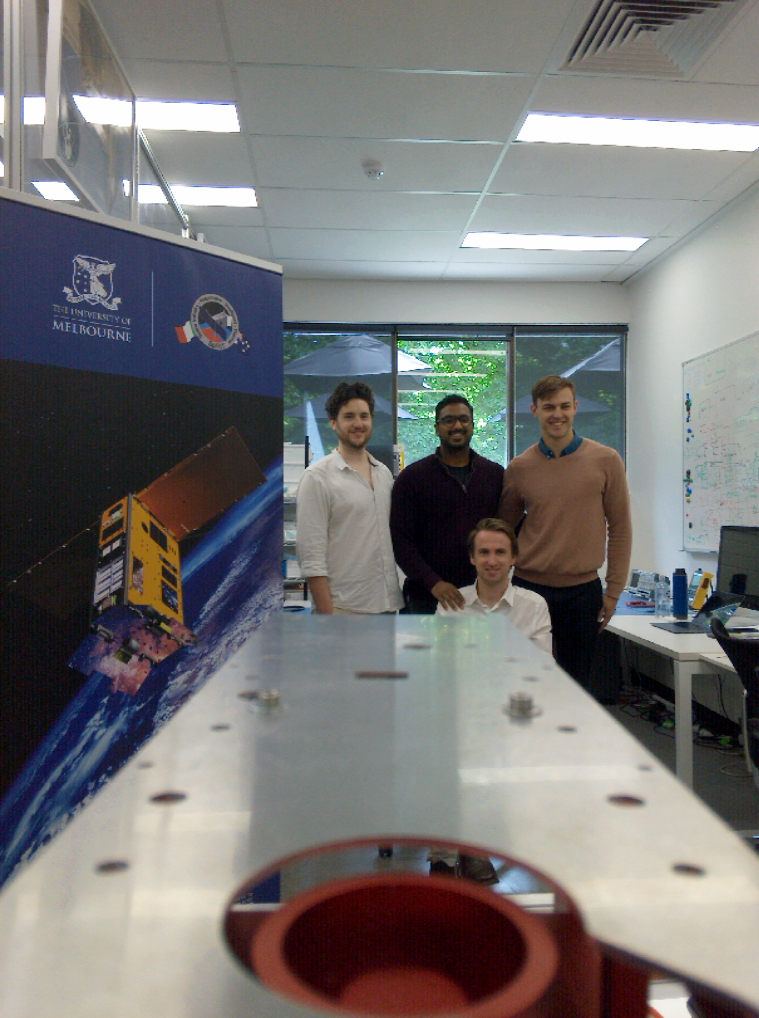4 Minute read
Life as a graduate researcher: Rob Mearns
Rob Mearns helps nanosatellites talk to their operations centres. Instrumentation he uses for his PhD research is packed aboard the SpIRIT nanosatellite, which was successfully launched into orbit around the Earth in late 2023.
PhD candidate Rob Mearns has had a rare opportunity to help launch the University of Melbourne’s Space Industry – Responsive – Intelligent – Thermal (SpIRIT) nanosatellite mission.
“I'm responsible for one of the payloads on the spacecraft,” he says.
Nanosatellites are small satellites ranging from 10 to 100 kilograms. They enable organisations with smaller budgets to put instrumentation in space.
But nanosatellites have limited communication with the Earth’s surface.
“Depending on your orbital path and where your ground stations are, you get two to six ground passes over your ground station every 24 hours,” Rob says.
“Let's say you have a satellite that's detecting bushfires. You don't want to have to wait for 12 hours to get that information.”
Rob’s research aims to improve communication between nanosatellites and their ground stations. He uses existing satellite communication infrastructure – the same infrastructure used by satellite phones.
Learn more about our graduate research options
How to balance a part-time PhD with part-time work

Rob is completing his PhD in Engineering and IT part-time while also working as a systems engineer part-time for the Melbourne Space Lab. He receives a pro rata research training program scholarship to support his research.
With a background in both physics and engineering, Rob can act as a bridge between scientists and engineers. He likes taking a scientific problem and figuring out an engineering solution – within the constraints of cost, the size of nanosatellites and the extreme conditions of space.
The Melbourne Space Lab team is very small. Members work closely together and get along well, Rob says. They have contributed to the SpIRIT project any way they can.
“I helped design the project and write the original proposal, and then specify the mission goals and design. I have helped carry it all the way through,” he says.
Rob has engaged with SpIRIT’s industry partners. “It was very beneficial to have had industry partners in Australia that we can work quite closely with and finetune what we want our spacecraft to do – as opposed to trying to buy something off the shelf that doesn't quite work and you have to just deal with,” Rob says.
Switching between the PhD researcher and systems engineer roles can be challenging, Rob admits. But being so involved with the project also has its benefits.
“I get a very good sense of what's going on with the spacecraft as a whole and what is going to be feasible. It has allowed me to finetune my experiments a little more,” he says.
The key is to be realistic about what he can achieve during his PhD.
"I have had to let go of some of the problems that do crop up and would be really interesting to look into,” he says.
PhD researchers can put a lot of pressure on themselves trying to contribute new things to human knowledge, Rob says.

You have to be kind to yourself. You don't have to make huge breakthroughs. Just increasing our knowledge a little bit is okay. Rob Mearns
SpIRIT launched aboard a SpaceX rocket in late 2023. It is currently in low Earth orbit for its two-year mission.
“Honestly, it was a great relief when SpIRIT went up and everything went smoothly,” Rob says.
"And to date, everything has worked exceptionally well – which for this class of mission, the amount of funding and the time we had for the project is just phenomenal."
How a passion for space led to a mission, a job and PhD candidacy
Rob has been at the University of Melbourne since his undergraduate studies in physics. Leaving school, his dream had been to study aerospace engineering. That wasn’t possible at the time.
“I'd kind of written off space at this point, because there just wasn't anything happening in Australia,” Rob says.
But the passion never left. During his Master of Engineering degree, he co-founded the Melbourne Space Program with other University of Melbourne students.
“The students design everything in the spacecraft. They build it. They deal with the legal side – the international launch companies, the government regulations, and the Australian Communications and Media Authority in terms of frequency allocations and things. They do all the testing,” Rob says.
The student organisation launched its first satellite, ACRUX-1, in 2019. It was one of the first completely student-led satellite development and launch initiatives in Australia.
Through the Melbourne Space Program, Rob met one of his PhD supervisors, Professor Michele Trenti. Completing some work for Professor Trenti eventually got Rob a job at the Melbourne Space Lab.
Rob was already working at the Melbourne Space Lab as a systems engineer when he decided to apply for the PhD. He thought the space industry outside the University of Melbourne would take him more seriously with the qualification.
He appreciated the opportunity to stay in Melbourne with his family and with academics he’d built strong relationships with for his PhD.
“My supervisors Associate Professor Airlie Chapman and Professor Michele Trenti have been incredibly helpful, and also understanding of personal circumstances,” Rob says.
“The lab is doing lots of exciting things and I plan on staying with them for as long as I can.”
First published on 20 March 2024.
Share this article
Keep reading
-
Why research with us
Explore the benefits of undertaking your graduate research at the University of Melbourne.
-
Your research options
Explore your options as a graduate researcher at the University of Melbourne.
-
Your study experience
Discover what it's like to be a graduate researcher. Find out about University life, support services, and opportunities for skills development.
-
How to apply
Find out how to apply for graduate research at the University of Melbourne.